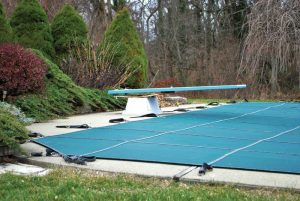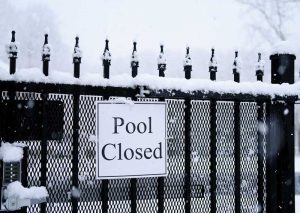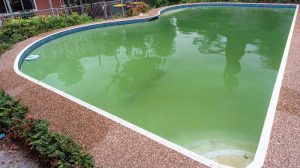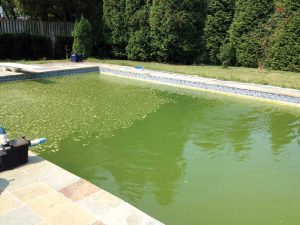Off-season essentials: Physical and chemical winterization
by arslan_ahmed | September 15, 2023 1:05 pm
 [1]
[1]By Alicia Stephens and Jamie Novak
Summer is winding down and as much as we do not want to, it is time to start thinking about winterizing pools. The sun is shining and the days are hot, but cooler nights and shorter days will be here and soon it will be time to close pools for the winter. The goal of winterizing a pool is to ensure the pool can be opened with ease and efficiency in springtime, with clean and clear water, ready for swimming with as little work as possible. Preparation is the key to successful winterization.
Why winterize?
When it comes to pool care in winter, there are three main objectives:
- The first is to provide sparkling water upon pool opening. Opening a pool that is clean and clear is the result of a successful winter care program.
- The second is to inhibit the growth of bacteria and algae. Proper winter care treatments can help prevent the buildup of contaminants, assisting with a faster turnaround time.
- The final objective of winter pool care is to protect the pool surface and equipment. Part of winter care is balancing the water. Balanced water will keep pH, total alkalinity, and calcium hardness in the correct range, reducing scaling and corrosion that can occur during the winter months.
The first element to consider when closing a pool is timing. The key to winter care is to not close the pool too early. In many cases, pools are opened and closed by the calendar. For example, many customers open their pool at the first of May or later and want to close it at Labour Day, regardless of weather conditions.
Water is often already warm when opening the pool and is still warm when closing the pool. Warm water is an ideal condition for bacterial growth and algae blooms. Winterizing chemicals applied to warm water will not be as efficient in the off-season or as effective at keeping the pool clean and clear. Chemicals added to warmer temperatures get used up at a faster rate because they have more work to do in warm water. Pools that are closed while warm or opened after the water turns warm are much more likely to be cloudy, green, and demand larger amounts of chlorine. Pools ideally should not be closed if the water temperature is above 21 C (70 F) and should be opened again before water reaches 21 C (70 F) in the spring. A liquid solar blanket can help reduce heat loss and extend the swimming season into the fall if a longer season is desired when temperatures start to drop at night.
 [2]
[2]Physical winterization
There are two categories of winterization that occur when closing a pool: physical and chemical. Physically winterizing a pool focuses on protecting pool equipment and surfaces from damage due to freezing. It also focuses on keeping dirt and debris out of the pool when the water is not circulating. The amount of physical winterization that must be done to protect a pool depends on the environment and the expected weather over the course of winter. In warmer climates, physically winterizing pumps, filters, and other equipment is often not necessary due to warmer temperatures in the off-season. However, unprecedented temperatures can occur as well, take Texas for example, where recently many pool owners were caught off guard with an unexpected freeze. In colder climates or if there is a risk of a deep freeze, steps should be taken to protect pumps, filters, and plumbing from freezing.
In colder climates, lowering the water level in the pool is recommended to help prevent damage from freezing water. The recommended level is usually below the skimmer opening or at a level advised by the pool’s manufacturer or builder. Freezing water can cause equipment, pipes, and fittings to crack, leading to costly repairs. It is recommended to blow out the lines once the water level has been lowered to protect against breakage. The addition of a skimmer plug can also help protect the skimmer from being damaged by freezing temperatures.
Regardless of the climate, covering the pool is an important part of off-season pool care. The pool will go long periods of time with no use, and most pool owners stop paying attention to maintenance activities such as brushing, skimming, and vacuuming in the off-season. Dirt and debris will form over the course of winter and covering the pool will reduce the need for these activities.
As winter progresses, keep excess water and debris cleaned off the top of the cover. If water and debris get too heavy, the cover can be pulled into the pool. This can damage the pool itself, and further create a big mess to clean up when the debris from the cover ends up in the pool too. In spring, when removing the winter cover, be careful not to allow dirt, debris, and contaminants on top of the cover to fall into the pool. This can create problems with filtration, water clarity, and chlorine demand, as well as other issues.
Chemical winterization
When chemically winterizing a pool, it is imperative to treat and remove all existing problems before closing. Closing a pool with issues will lead to problems getting worse over the course of winter, causing additional time and chemicals during spring opening.
 [3]
[3]Water balance, sanitizer residual, and water clarity should all be evaluated and balanced before a pool is closed. Clearing up problems before closing allows the winterizing program to work effectively, and helps open the pool quickly and easily in the spring.
Water balance should be considered first when winterizing a pool—pH, total alkalinity (TA), and calcium hardness should all be balanced to ideal parameters. Winter temperatures bring colder water, which can lead to a corrosive environment. Prolonged exposure of corrosive water to the pool’s surfaces may cause etching and metal staining to become more prominent on pool surfaces; it can also lead to potential damage to pool equipment.
In addition to balancing the pool water before closing, a stain and scale control product should be added at closing to protect the pool from surface problems and metal-based staining or water discoloration. These products are a great combination to provide superior protection over the course of winter as they get the pool started off in the right way when summers rolls around again.
A chlorine residual is important to maintain when closing the pool. Establishing a 1 to 4 ppm residual before adding winterizing chemicals is ideal, as the longer a residual is maintained, the easier spring opening will be. If no residual is present at closing, the pool is likely to experience chlorine demand at opening. This contamination buildup in the water can consume larger than typical amounts of chlorine and make it difficult to establish a residual. If a pool is closed while experiencing a chlorine demand, the water is likely to be cloudy or problematic when opening. The contamination will go unchecked during the winter, and bacteria and algae will grow in the absence of a chlorine residual. This will lead to a more substantial demand upon opening and increased amounts of chlorine to establish a residual at spring opening. Chlorine demand must be addressed and corrected before winterization.
Enhancing the winterization process
There are many options for winterizing chemicals and winter kits are available when it is time for closing. Regardless of which kit you choose, all pools should be brushed and vacuumed, and shocked with a chlorine oxidizer before closing. In addition to the basics, however, there are many other specialty options to enhance the winterizing process.

Adding algaecide to prevent algae growth over the winter is an effective way to help open a pool with clear water in the spring. It can often be difficult to maintain a chlorine residual through the entirety of the off-season, especially when using a mesh cover. If the chlorine residual drops below 1 ppm, the presence of a preventative algaecide will continue to protect the pool from algae growth. This will help avoid opening a green, swampy pool in the spring.
There are many preventative measures you can take at closing to simplify the opening process, requiring less work and less time to get the pool ready for swimming. The addition of a quality broad-spectrum enzyme product can be a key element to water clarity and surface cleanliness at opening. Enzymes, paired with a surfactant, will break down non-living contaminants in the water, reducing the workload for chlorine. In the presence of enzymes, pools will have better water quality upon opening, be more likely to maintain a chlorine residual in the off-season, and will not have a scum line accumulation at the waterline that needs to be physically scrubbed off the surface.
Reducing and minimizing the level of phosphate in the pool upon closing is also a key initiative to take to help ensure a faster turnaround time at opening. The addition of a phosphate remover will improve water quality and clarity, while increasing the probability that the pool will open with clean and clear water. The addition of a multi-functional product that contains both enzymes and a phosphate remover can be a key element in helping prevent problems over the course of the winter.
 [4]
[4]Closing thoughts
No matter which chemical options you choose for closing, it is imperative to keep an eye on the pool over the winter. In some cases, it might be necessary to add additional winterizing chemicals underneath the cover to prevent problems. Many service professionals even offer an off-season “check” service for pools one time per winter. As mentioned, the timing for closing in general is just as important as chemical treatment and equipment preparation. Close late and open early. However, when you do close, proper preparation and treatment will make opening in the spring a much simpler job.
Authors
 Alicia Stephens is the director of training and education for BioLab Inc. In her 22 years with the company, she has focused primarily on education, training, and development, as well as technical support and new product research and integration. Currently, Stephens supports all education and training initiatives for the BioLab Pro Dealer division.
Alicia Stephens is the director of training and education for BioLab Inc. In her 22 years with the company, she has focused primarily on education, training, and development, as well as technical support and new product research and integration. Currently, Stephens supports all education and training initiatives for the BioLab Pro Dealer division.
 Jamie Novak is the director of pro brands at BioLab, a division of KIK Consumer Products. With more than 18 years of experience in the swimming pool and spa industry, she has held multiple positions in marketing and sales for major manufacturers. Novak received her MBA with concentrations in marketing and leading organizations from Johns Hopkins Carey Business School.
Jamie Novak is the director of pro brands at BioLab, a division of KIK Consumer Products. With more than 18 years of experience in the swimming pool and spa industry, she has held multiple positions in marketing and sales for major manufacturers. Novak received her MBA with concentrations in marketing and leading organizations from Johns Hopkins Carey Business School.
- [Image]: https://www.poolspamarketing.com/wp-content/uploads/2023/09/OPENER_bigstock-Aerial-Drone-Point-Of-View-Of-391827755.jpg
- [Image]: https://www.poolspamarketing.com/wp-content/uploads/2023/09/dreamstime_l_166439987_Photo-166439987-©-Picturethisimages-_-Dreamstime.com_.jpg
- [Image]: https://www.poolspamarketing.com/wp-content/uploads/2023/09/PoolClosed_dreamstime_m_174123388.jpg
- [Image]: https://www.poolspamarketing.com/wp-content/uploads/2023/09/Courtesy-NCBrands-JN-algae.jpg
Source URL: https://www.poolspamarketing.com/trade/features/off-season-essentials-physical-and-chemical-winterization/